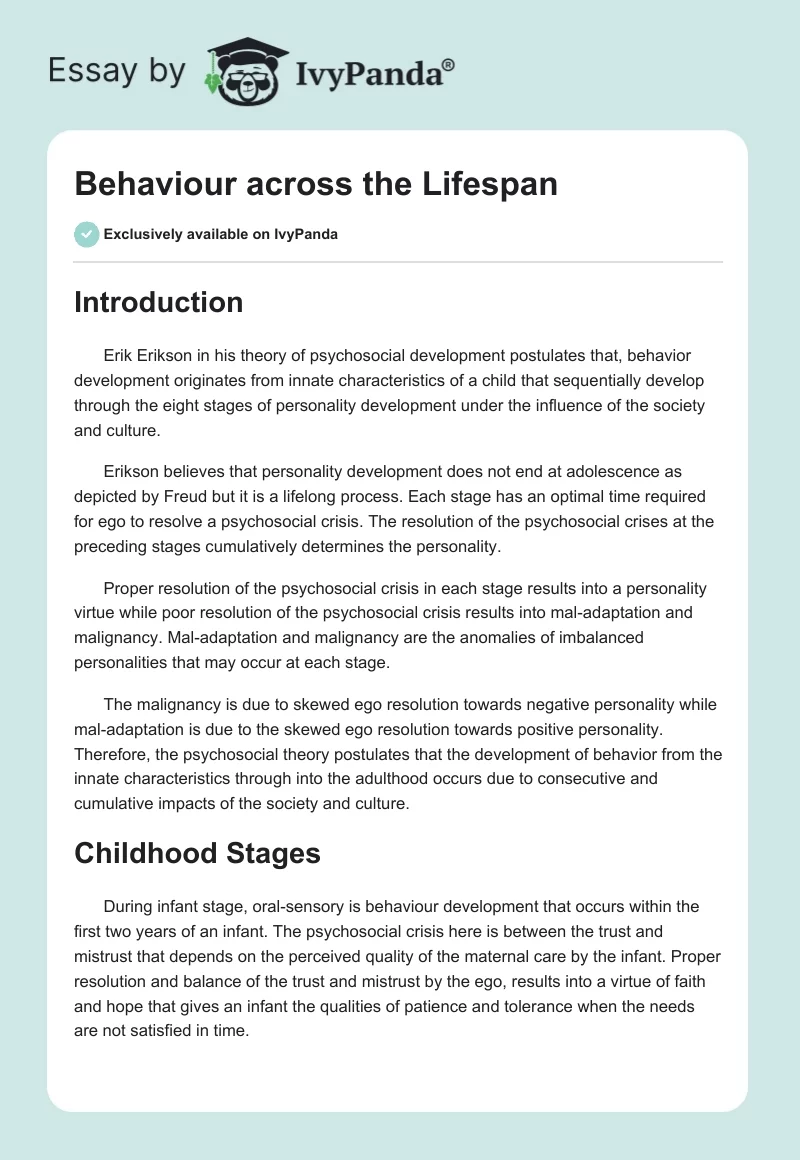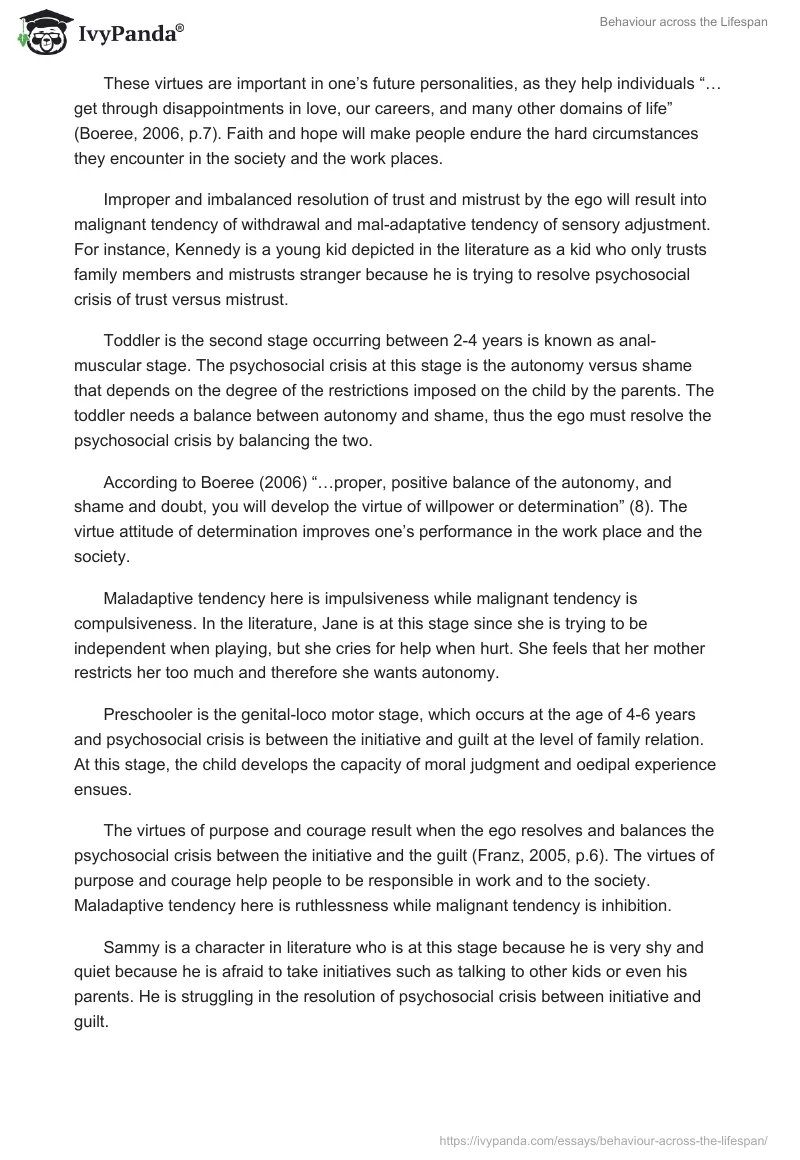Introduction
Erik Erikson in his theory of psychosocial development postulates that, behavior development originates from innate characteristics of a child that sequentially develop through the eight stages of personality development under the influence of the society and culture.
Erikson believes that personality development does not end at adolescence as depicted by Freud but it is a lifelong process. Each stage has an optimal time required for ego to resolve a psychosocial crisis. The resolution of the psychosocial crises at the preceding stages cumulatively determines the personality.
Proper resolution of the psychosocial crisis in each stage results into a personality virtue while poor resolution of the psychosocial crisis results into mal-adaptation and malignancy. Mal-adaptation and malignancy are the anomalies of imbalanced personalities that may occur at each stage.
The malignancy is due to skewed ego resolution towards negative personality while mal-adaptation is due to the skewed ego resolution towards positive personality. Therefore, the psychosocial theory postulates that the development of behavior from the innate characteristics through into the adulthood occurs due to consecutive and cumulative impacts of the society and culture.
Childhood Stages
During infant stage, oral-sensory is behaviour development that occurs within the first two years of an infant. The psychosocial crisis here is between the trust and mistrust that depends on the perceived quality of the maternal care by the infant. Proper resolution and balance of the trust and mistrust by the ego, results into a virtue of faith and hope that gives an infant the qualities of patience and tolerance when the needs are not satisfied in time.
These virtues are important in one’s future personalities, as they help individuals “…get through disappointments in love, our careers, and many other domains of life” (Boeree, 2006, p.7). Faith and hope will make people endure the hard circumstances they encounter in the society and the work places.
Improper and imbalanced resolution of trust and mistrust by the ego will result into malignant tendency of withdrawal and mal-adaptative tendency of sensory adjustment. For instance, Kennedy is a young kid depicted in the literature as a kid who only trusts family members and mistrusts stranger because he is trying to resolve psychosocial crisis of trust versus mistrust.
Toddler is the second stage occurring between 2-4 years is known as anal-muscular stage. The psychosocial crisis at this stage is the autonomy versus shame that depends on the degree of the restrictions imposed on the child by the parents. The toddler needs a balance between autonomy and shame, thus the ego must resolve the psychosocial crisis by balancing the two.
According to Boeree (2006) “…proper, positive balance of the autonomy, and shame and doubt, you will develop the virtue of willpower or determination” (8). The virtue attitude of determination improves one’s performance in the work place and the society.
Maladaptive tendency here is impulsiveness while malignant tendency is compulsiveness. In the literature, Jane is at this stage since she is trying to be independent when playing, but she cries for help when hurt. She feels that her mother restricts her too much and therefore she wants autonomy.
Preschooler is the genital-loco motor stage, which occurs at the age of 4-6 years and psychosocial crisis is between the initiative and guilt at the level of family relation. At this stage, the child develops the capacity of moral judgment and oedipal experience ensues.
The virtues of purpose and courage result when the ego resolves and balances the psychosocial crisis between the initiative and the guilt (Franz, 2005, p.6). The virtues of purpose and courage help people to be responsible in work and to the society. Maladaptive tendency here is ruthlessness while malignant tendency is inhibition.
Sammy is a character in literature who is at this stage because he is very shy and quiet because he is afraid to take initiatives such as talking to other kids or even his parents. He is struggling in the resolution of psychosocial crisis between initiative and guilt.
Educational Stages
School age is the fourth stage in psychosocial development and it occurs between the ages of 6-12 years. The psychosocial crisis is industry versus inferiority that occurs in the context of the community and the school.
At this stage, the balance between industry and inferiority results into the virtue of competence (Davis & Clifton 1995, p.12). The virtue of competence in one’s live makes him/her achieve satisfaction in work and serving the society. The mala-adaptative tendency is narrow virtuosity while malignant tendency is inertia.
Bernard is a character at this stage because he is a hardworking pupil in his class because he does his homework in time for he fears that he will be the last in class. Inferiority complex threatens his competence in class that is why he is struggling to have proper resolution of psychosocial crisis of industry versus inferiority.
Adolescence stage is the fifth stage occurring between the ages of 12-18 years. The psychosocial crisis is between ego identity and the role confusion in the context of peer groups and role models.
The virtue of fidelity is achieved when there is proper resolution of the psychosocial crisis by the ego (Horst, 2001, p.12). Fidelity makes individuals to conform to the demands of the work and the society in spite of the challenges. The anomalies at this stage are identity crises as repudiation, which surfaces as the malignant tendency and fanaticism as the maladaptive tendency.
In literature, Obadiah is facing identity crisis because he is emulating celebrities that he constantly watches in television. He believes that the lifestyles and the lives of celebrities are more important than education. Therefore, Obadiah is in the process resolving identity crisis.
Adult Stage
The sixth, seventh and the eight stages fall under adult stage between the ages of 18 and beyond. The psychosocial crises are intimacy versus isolation, generativity versus stagnation and integrity versus despair. The psychosocial crises occur in the context of friends, partners, workmates, and the society.
If the psychosocial crises are resolved and balanced very well, the virtues of love, care, and wisdom are obtained (Davis & Clifton, 1995, p.15). The virtues of love and care are what make people have healthy relationships with their partners, families, friends, community, and the whole society. The mal-adaptations at these stages are promiscuity, overextension, and presumption while malignant tendencies are exclusion from relationships in the young adult and middle adult.
Mary is at this stage since she is very busy juggling family matters, career, and leadership in the society. She is trying to develop intimate relationship with family members, to nurture her marital relationship and become a leader in the community all at the same time.
Review of Articles
The articles by Franz, Granger, Kivlighan, and Horst regarding psychosocial theory support Erik Erikson’s arguments. While psychosocial theory postulates that behavior development occurs due to the epigenetic factors and influence from the society,
Granger and Kivlighan add that, “development is considered a product of individual and interactive influences among genetic, environmental, social, and biological process overtime” (2003, p. 1052). They support the eight stages of psychosocial development according to Erik Erikson. Horst also explains that identity and intimacy are the elements that define and differentiate male from female.
In resolution of the psychosocial crisis of identity versus role confusion, female depend upon their male counterparts while male can resolve their psychosocial crises independently. This argument supports the psychosocial theory that development of behaviour depends upon interaction of epigenetic factors and social factors.
In support of Erick Erikson’s theory, Franz holds that, men develop their behaviour by individuation while female develop it through attachment to their mothers. I agree with the conclusions of the study since there are consistent and credible arguments from various theorists that support the development of behaviour across lifespan.
Conclusion
The Erikson’s theory of psychosocial development of personality clearly elucidates the sequential development of personality from the innate personality of an infant into adulthood through a cumulative effect of the societal and cultural factors.
The personality development according to this theory depends on the resolution of psychosocial crisis at each stage in order to achieve virtues, which are good attributes in a person. Many other theorists such as Franz, Granger, Kivlighan, and Horst have consistently rooted for the psychosocial theory by developing theories that are in tandem with Erikson’s arguments.
References
Boeree, G. (2006). Erik Erikson: Personality Theories. Psychology Department Shippensburg University, 1-83.
Davis, D., & Clifton, A. (1995). Psychosocial Theory: Erikson. Haverford Journal of Psychology, 7(2), 1-37.
Franz, C. (2005). Individuation and attachment in Personality Development: Extending
Erikson’s Theory. Psychological theories, 53(12), 1-25.
Granger, A., & Kivlighan, K. (2003) Integrating Biological, Behavioral, and Social levels
Of Analysis in Early Child Development: Progress, Problems, and Prospects. Journal of Childhood Development, 74(4), 1050-1063.
Horst, E. (2001). Re-examining Gender Issues in Erikson’s Stages of Identity and Intimacy. Journal of Counseling and Development, 73 (3), 1-34.


